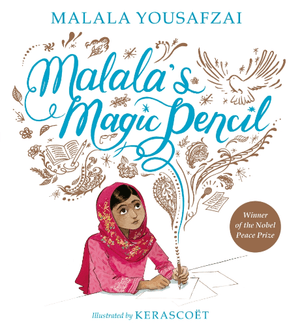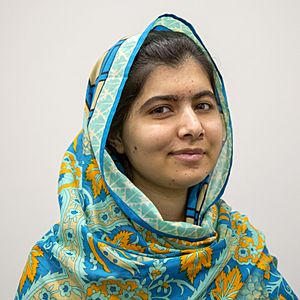Malala's Magic Pencil facts for kids

Front cover
|
|
| Author | Malala Yousafzai |
|---|---|
| Illustrator | Kerascoët (internal illustrations) Sarah J. Coleman (title lettering and illustration) |
| Language | English |
| Genre | Picture book, autobiography |
| Publisher | Little, Brown and Company |
|
Publication date
|
17 October 2017 |
| Media type | |
| Pages | 48 |
| ISBN | 9780316319577 |
| OCLC | 3999882421 |
Malala's Magic Pencil is a special picture book written by Malala Yousafzai in 2017. The book was illustrated by Kerascoët. It tells the story of Malala growing up in Swat, Pakistan. She used to wish for a magic pencil to solve her problems. But she soon learned that she could make big changes, like helping girls go to school, without any magic at all. The book has received many good reviews. People have praised both Malala's writing and the beautiful pictures by Kerascoët. It is often listed as one of the best children's books from 2017.
Contents
Malala's Story: A Young Activist
Malala Yousafzai is a brave activist from Pakistan. She works hard to make sure girls can go to school. Malala was born in Swat Valley in Pakistan on 12 July 1997. She grew up with her parents, Ziauddin Yousafzai and Tor Pekai Yousafzai, and two younger brothers.
Malala's Early Activism
When Malala was just 11 years old, she started writing a secret blog for BBC Urdu. In her blog, she wrote about her life in Pakistan. She described how the Taliban, a group that did not want girls to go to school, was gaining power. After her blog, she was featured in a New York Times film. She also spoke out in local news about the importance of female education.
In December 2009, people found out Malala was the author of the blog. As she became more well-known, she started to receive threats. On 9 October 2012, Malala was hurt on her way home from school because of her brave work. She was taken to hospitals in Pakistan and then in England.
Malala's Global Voice
Malala continued to speak up for girls' rights around the world. At age 17, she made history. She became the youngest person ever to win the Nobel Peace Prize in 2014. This award is given to people who have done amazing things for peace.
In 2013, Malala wrote her life story, I Am Malala, with Christina Lamb. This book became a bestseller. A special version for young people was released in 2014.
Creating Malala's Magic Pencil
Malala decided to write a picture book because many young children were interested in her story. She wanted them to see that even one person's actions can create change. News of her writing a picture book came out in October 2016.
Inspiration for the Book
Malala's Magic Pencil was inspired by an Indian TV show. The show was called Shaka Laka Boom Boom and was about a boy with a magic pencil. Malala said that writing her book was a lot of work. She had to check dates and facts carefully. She also helped choose the artists and decide how to show everything in pictures. She even made sure the art looked just like her childhood home.
Publication Details
Malala's Magic Pencil was published on 17 October 2017. Little, Brown and Company published it in the U.S. and Puffin Books published it in the U.K. French artists Marie Pommepuy and Sébastien Cosset, known as Kerascoët, created the artwork inside the book. Sarah J. Coleman, also known as Inkymole, designed the front cover.
Book Summary: The Power of Your Voice
The book is told from Malala Yousafzai's point of view. It shows her as a child, wishing for a magic pencil to fix problems in her life. The pictures show her childhood home in Swat Valley. The book uses simple words and beautiful watercolor illustrations. It also has shiny gold and bronze details. The book is written for young readers, usually between ages 4 and 8.
The story starts by asking, "Do you believe in magic?" Malala then talks about the TV show with the magic pencil. She says if she had one, she would use it for small things. For example, she would stop time to get more sleep. Or she would create a football for her brothers to play with.
As Malala gets older, her wishes for a magic pencil become more serious. She starts to wish for peace in the world. Even though she never gets a magic pencil, she learns something important. She realizes she can change the world without one. By writing speeches about how unfair it is for girls not to go to school, she can make a big difference. Her story teaches us that our own voices can be powerful.


